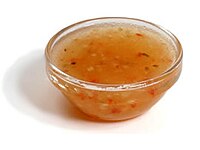
Photo from wikipedia
BACKGROUND Salad dressings formulation includes a pH within 3.2-4.1, salt and other solutes to depress water activity. The interaction between hydrocolloids and other components, such as humectants determines their physical… Click to show full abstract
BACKGROUND Salad dressings formulation includes a pH within 3.2-4.1, salt and other solutes to depress water activity. The interaction between hydrocolloids and other components, such as humectants determines their physical and microbiological stability. To our knowledge, the effect of commonly used solutes on physical stability and rheological characteristics of oil-in-water emulsions stabilized by xanthan gum was not reported. Neither the effect of a spoilage yeast on the physical stability was evaluated. RESULTS The effect of different humectants (sodium chloride, glucose, and xylitol) and Zygosaccharomyces bailii inoculation on the stability of oil-in-water emulsions containing different levels of xanthan gum to emulate different types of salad dressings was investigated by means of droplet size, zeta potential, rheological measurements, and Confocal Laser Scanning Microscopy (CLSM). Generally, the addition of humectants strengthened the weak or strong emulsion structure, especially xylitol. Glucose or xylitol acted as stabilizers since they decreased Sauter and De Broucker diameter. On the contrary, NaCl destabilized the emulsions since it increased droplet size and exhibited the lowest absolute values of zeta potential. Inoculation with Z. bailii destabilized some emulsions since it increased Sauter and De Broucker diameter. Emulsion's droplet size, their polydispersity, and xanthan gum and yeast's location were confirmed by CLSM imaging. CONCLUSION This study highlights the key role of humectants and xanthan gum level on physical characteristics and stability of oil-in-water emulsions. Addition of xylitol leads to an enhancement in emulsion rheology and physical stability, suggesting it is a potential low-calorie multi-functional additive for salad dressings. This article is protected by copyright. All rights reserved.
Journal Title: Journal of the science of food and agriculture
Year Published: 2022
Link to full text (if available)
Share on Social Media: Sign Up to like & get
recommendations!